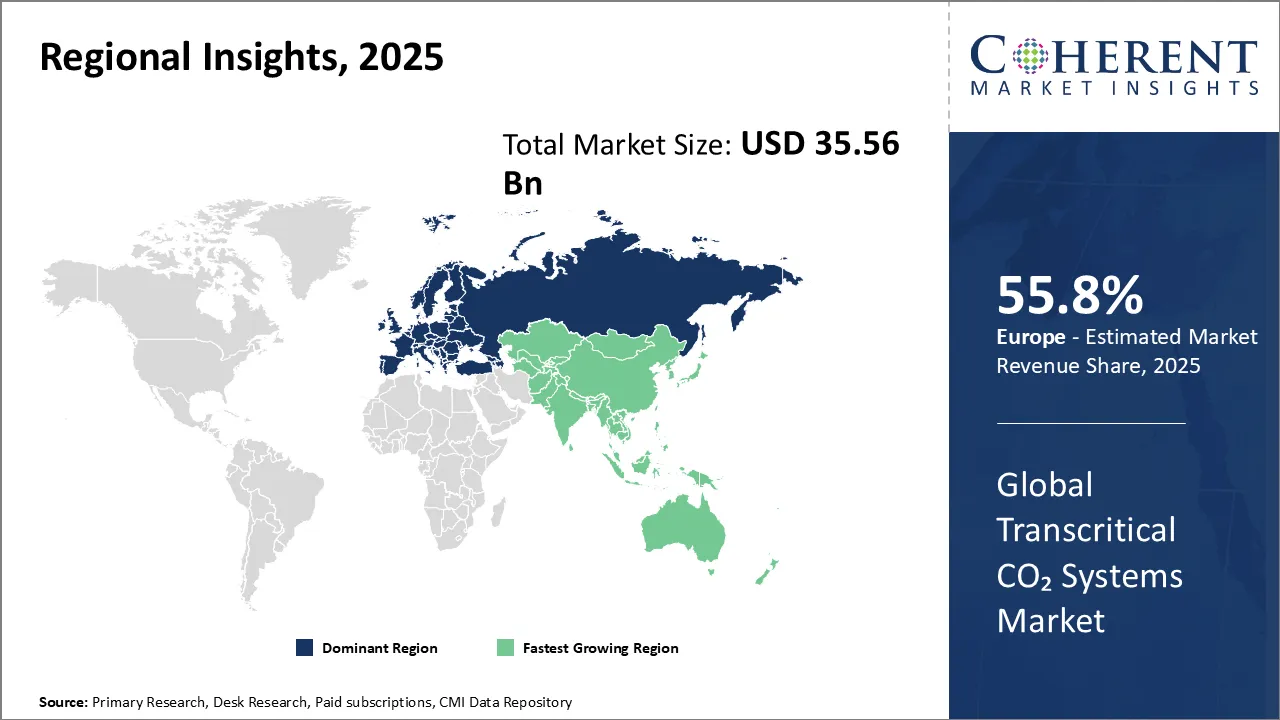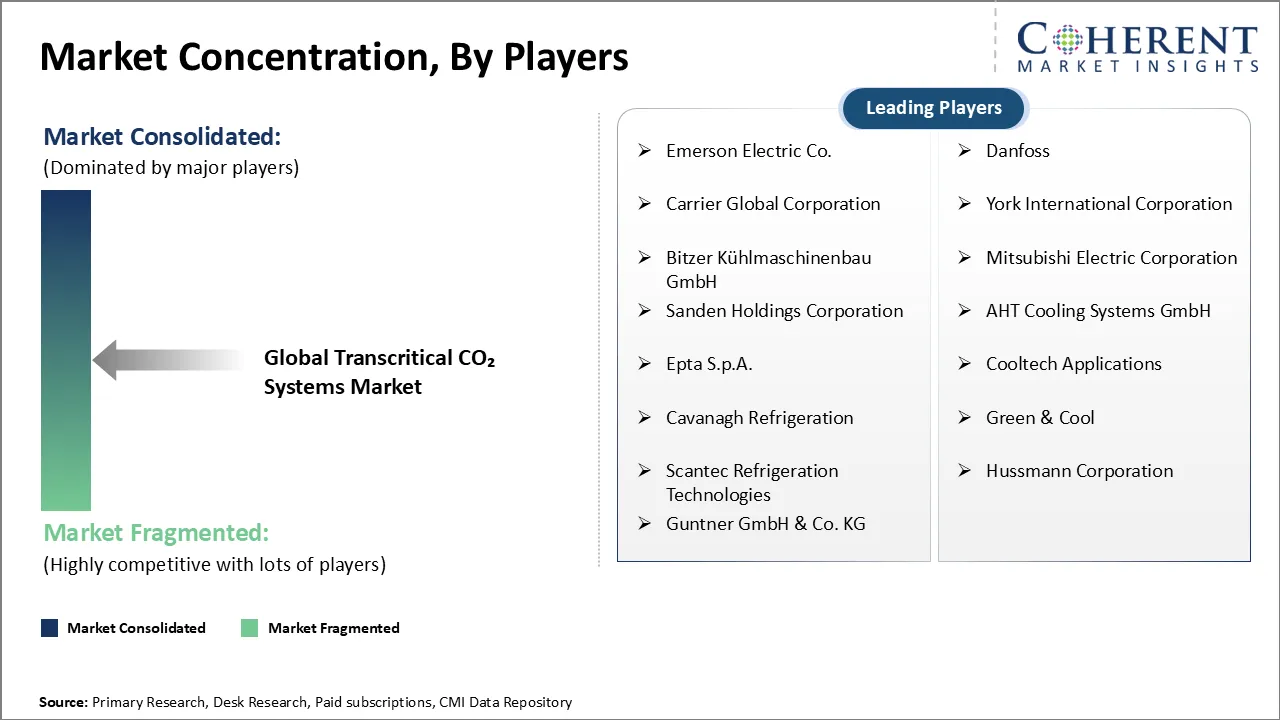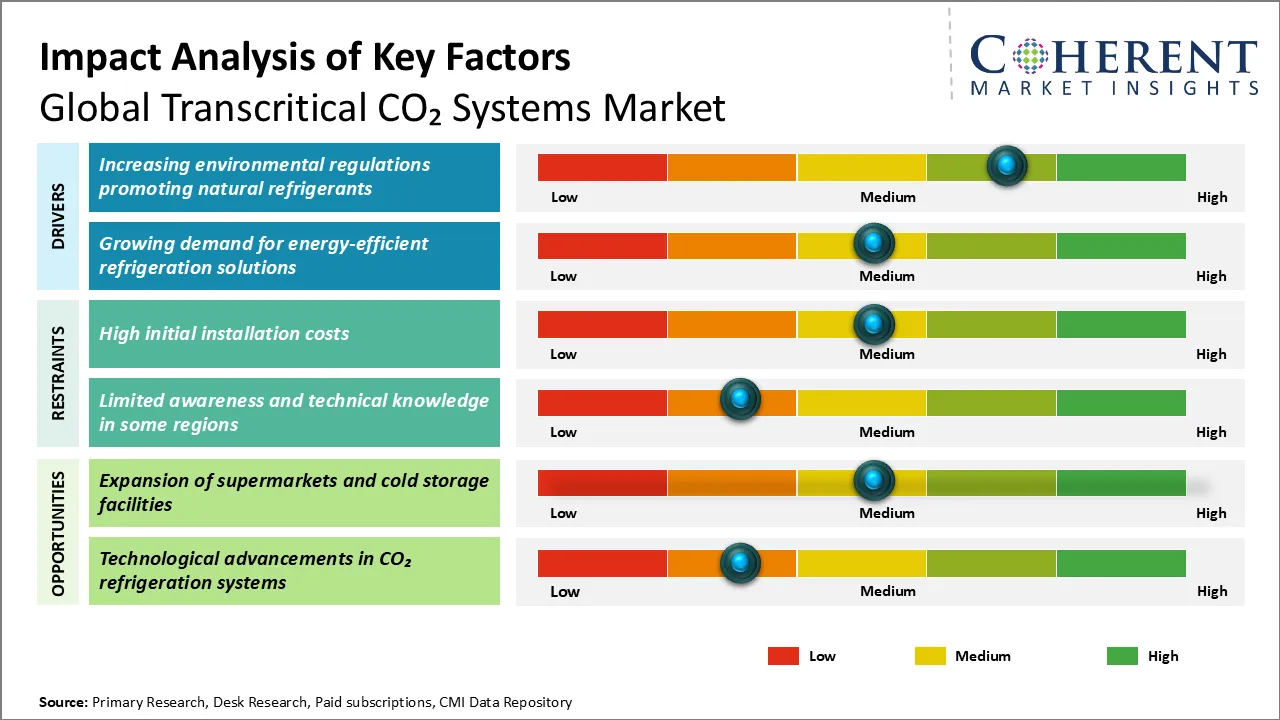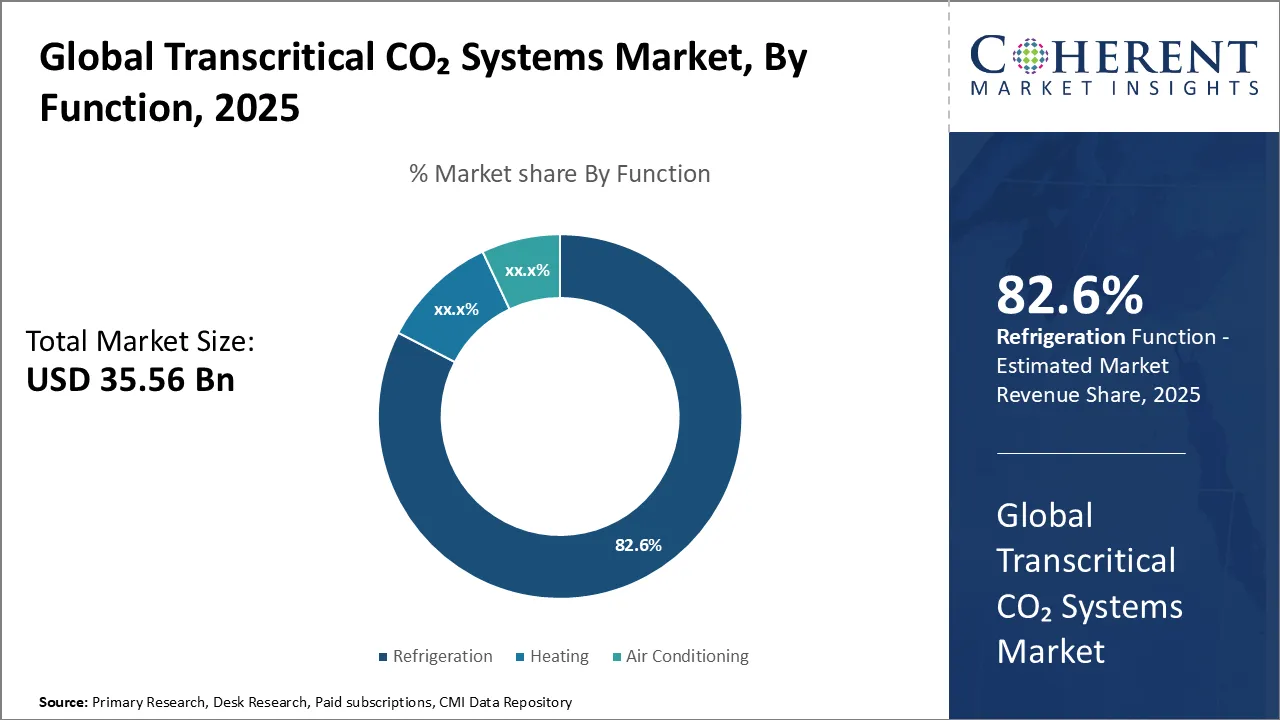Global Transcritical CO2 Systems Market Size and Forecast – 2025-2032
The Global Transcritical CO2 Systems Market is estimated to be valued at USD 35.56 Bn in 2025 and is expected to reach USD 102.33 Bn by 2032, exhibiting a compound annual growth rate (CAGR) of 16.3% from 2025 to 2032.
Key Takeaways of the Transcritical CO2 Systems Market
- The refrigeration segment is expected to account for 82. 6% of the global transcritical CO2 systems market in 2025, driven by the growing demand for sustainable and eco-friendly cooling solutions.
- The retail segment is projected to hold a 31. 2% market share in 2025, largely driven by the increasing demand for eco-friendly and efficient cold chain solutions in supermarkets and convenience stores.
- The compressors segment is expected to account for 35. 8% of the global transcritical CO2 systems market in 2025, driven by ongoing technological advancements and their crucial role in system performance.
- Europe is expected to lead the global transcritical CO2 systems market in 2025 with a 55. 8% share, driven by the increasing adoption of environment-friendly refrigeration solutions and stringent environmental regulations. Asia Pacific, with a 17.5% share in 2025, will be the fastest-growing region, fueled by rapid industrialization, increasing demand for sustainable cooling systems, and growing government support for green technologies in sectors like retail and food processing.
Market Overview
Market trends highlight a growing adoption of transcritical CO2 systems in commercial and industrial refrigeration due to their low global warming potential and superior energy efficiency compared to conventional refrigerants. Innovations, such as enhanced system designs and integration with renewable energy sources, are accelerating market expansion. Additionally, government incentives and stringent carbon footprint reduction policies worldwide are encouraging market players to invest in transcritical CO2 technologies, further propelling this market toward rapid growth and widespread implementation.
Current Events and Its Impact
|
Current Events |
Description and its impact |
|
Stricter Environmental Regulations and HFC Phase-Out in Europe |
|
|
Technological Advancements and R&D Investment |
|
Uncover macros and micros vetted on 75+ parameters: Get instant access to report
Transcritical CO2 Systems Market Insights, By Function – Refrigeration’s Dominance is Driven by Sustainability and Regulatory Push
Refrigeration segment is expected to contribute 82.6% share of the global transcritical CO2 systems market in 2025, owing to the increasing emphasis on sustainable and environment-friendly cooling solutions. Refrigeration is a critical function in a wide range of industries, including retail, food processing, and pharmaceuticals, all of which require reliable, energy-efficient temperature control. The rising global focus on reducing greenhouse gas emissions has significantly propelled the adoption of transcritical CO2 systems in refrigeration applications.
Transcritical CO2 Systems Market Insights, By Application – Retail Segment Lead with Emphasis on Eco-Conscious Cold Chain Solutions
Retail segment contributing an estimated 31.2% market share in 2025, primarily due to the widespread need for eco-conscious and efficient cold chain solutions in supermarkets and convenience stores. Retailers are increasingly adopting transcritical CO2 refrigeration systems to meet both regulatory requirements and consumer expectations for sustainable practices. The retail sector's dependence on refrigeration for fresh produce, frozen foods, and perishable goods underscores the essential role of highly reliable cooling systems that also minimize environmental impact.
Transcritical CO2 Systems Market Insights, By Component - Compressor Segment Dominates Due to Technological Advancements and Energy Efficiency
Compressors segment is expected to contribute 35.8% share of the global transcritical CO2 systems market in 2025, fueled by continuous technological advancements and their pivotal role in system performance. Compressors are the heart of any CO2 refrigeration or heat pump system, responsible for circulating the refrigerant and maintaining the necessary pressure differentials in transcritical cycles. Given the unique challenges posed by CO2’s high operating pressures and variable transcritical conditions, the compressor design has evolved significantly to support efficient, reliable system function.
Regional Insights

To learn more about this report, Download Free Sample
Europe Transcritical CO2 Systems Market Analysis and Trends
The Europe region is projected to lead the market with a 55.8% share in 2025, driven by the region's strong emphasis on sustainable refrigeration technologies and stringent environmental regulations. European governments have been proactive in implementing policies that encourage the reduction of greenhouse gas emissions, including the F-gas Regulation, which promotes the use of natural refrigerants such as CO2.
This regulatory environment fosters innovation and adoption of transcritical CO2 systems across commercial refrigeration and industrial applications. The mature market ecosystem is supported by well-established industry players like Bitzer (Germany), Embraco (Italy), and Danfoss (Denmark), which have contributed significantly to system efficiency improvements and technology advancements. Europe's extensive cold chain infrastructure and large retail sector further enhance the demand for environment-friendly refrigeration solutions, maintaining the region's leadership in this market.
Asia Pacific Transcritical CO2 Systems Market Analysis and Trends
The Asia Pacific region is expected to exhibit the fastest growth in the market contributing an estimated 17.5% share in 2025 due to rapid industrialization, urbanization, and increasing environmental awareness. Countries like China and Japan are investing heavily in upgrading refrigeration and HVAC infrastructure to meet stricter energy efficiency and emission control standards.
Government initiatives promoting green technology adoption, such as subsidies and favorable import-export policies, accelerate the deployment of transcritical CO2 systems. The presence of local manufacturing hubs and growing partnerships with international companies help overcome cost and technology barriers. Notable companies including Panasonic (Japan), Midea (China), and Mitsubishi Electric (Japan) actively contribute to market expansion through innovative products tailored to regional needs. The rising retail and food processing sectors in countries, such as India and South Korea, also play key roles in this rapid market development.
Global Transcritical CO2 Systems Market Outlook for Key Countries
Germany Transcritical CO2 Systems Market Trends
Germany transcritical CO2 systems market is robust with a strong focus on energy efficiency and environmental sustainability. It benefits from a well-established manufacturing base and a proactive regulatory framework favoring CO2 refrigeration solutions. German industry leaders like Bitzer and Viessmann actively drive R&D to develop advanced transcritical systems, bolstering commercial refrigeration and cold storage sectors. The country’s leadership in green technologies, combined with its strong export orientation, continually influences the broader European market.
Japan Transcritical CO2 Systems Market Trends
Japan continues to lead in innovation and implementation of transcritical CO2 refrigeration systems. The government’s support through policies encouraging low-GWP refrigerants and energy conservation influences widespread market adoption. Japanese companies such as Panasonic and Mitsubishi Electric are pioneers in compact, efficient systems suitable for retail and industrial use, contributing significantly to product diversification. Japan’s early adoption trend also positions it as a technology incubator for the Asia Pacific region.
China Transcritical CO2 Systems Market Trends
China transcritical CO2 systems market is expanding rapidly as environmental regulations tighten and the government promotes sustainable industrial upgrades. Local players like Midea and Qingdao Haier are investing in domestic manufacturing and system integration capabilities, reducing reliance on imports while fostering innovation. The large-scale development of supermarkets, logistics, and food processing industries acts as a key demand driver. China also actively engages in international collaborations, accelerating technology transfer and market penetration.
India Transcritical CO2 Systems Market Trends
India transcritical CO2 systems market is emerging with strong growth prospects fueled by industrial growth and increasing demand for environment-friendly refrigeration. Government initiatives supporting energy efficiency and natural refrigerant adoption are gradually influencing the sector. Local manufacturers and international entrants are collaborating to deliver cost-effective transcritical CO2 solutions adapted to regional climatic conditions. Expanding retail chains and cold storage infrastructure investments underpin rising demand, marking India as a pivotal player in the global market’s future trajectory.
Transcritical CO2 Systems Market Is Influenced by Various Macroeconomic and Microeconomic Factor
Macroeconomic Factors
Economic Growth and Industrial Expansion
- Impact: Economic growth in key regions like North America, Europe, and Asia Pacific drives the demand for cooling and refrigeration systems across various industries. Industrial growth and urbanization lead to an increase in infrastructure development, which consequently boosts the demand for transcritical CO2 systems used in commercial refrigeration.
- Details: As economies expand, new retail outlets, food processing plants, and supermarkets emerge, all requiring efficient and eco-friendly refrigeration systems. This trend is particularly pronounced in developing regions, where industrial growth is robust.
Microeconomic Factors
Cost of Technology and System Installation
- Impact: High upfront costs for the installation of transcritical CO2 systems can be a barrier for small and medium-sized enterprises (SMEs). The installation involves specialized equipment and expertise, which increases the overall cost.
- Details: While operational costs are lower due to energy efficiency, initial capital expenditure remains a concern. Businesses often weigh the long-term savings against these upfront costs. This makes it critical for system manufacturers to offer financial solutions or incentives to ease adoption.
Market Players, Key Development, and Competitive Intelligence

To learn more about this report, Download Free Sample
Key Developments
- In May 2025, Hussmann, a Panasonic Company, announced a strategic partnership with Refra to become the exclusive supplier of advanced refrigeration systems in the Australian transcritical CO2 systems market. The collaboration will center on innovative Transcritical CO2 racks, chillers, and R290 heat pump technologies. This alliance marks a significant milestone in Hussmann’s efforts to expand its natural refrigerant systems portfolio and strengthen its position as Australia’s leading AIRAH, the Australian Institute of Refrigeration.
- In August 2024, an ice rink in Santander completed a major retrofit, replacing its R-22 refrigeration system with a packaged 190 TR (668 kW) transcritical CO2 system equipped with Güntner’s V-shape VARIO gas cooler featuring hydroBLU adiabatic technology. According to Güntner’s Vice President of Sales, Mr. Jascha Heynck, the innovative gas cooler operates dry for about 90% of the year, requiring water only during peak conditions. This advanced fan and water management system significantly reduces electricity and water consumption, delivering improved energy efficiency and sustainable performance.
- In June 2024, U.S.-based OEM, Hillphoenix, introduced ChargeSecure, an innovative charge preservation system designed for CO2 (R744) refrigeration systems. This compact solution maintains the refrigerant charge during power outages and service events, minimizing downtime and enabling immediate system restart once power is restored. According to Hillphoenix, ChargeSecure helps stores resume operations faster and offers enhanced reliability and peace of mind for retailers relying on CO2 refrigeration technology.
- In March 2023, Emerson introduced the Copeland transcritical CO2 semi-hermetic reciprocating compressor, model 4MTLS28ME, featuring the largest displacement within its series. This versatile unit functions both as a standard medium-temperature compressor and as a parallel compressor in transcritical CO2 booster systems. With a capacity of 303 kBTU/hour, it offers greater design flexibility and has the potential to reduce the total number of compressors required in transcritical CO2 rack configurations.
Top Strategies Followed by Global Transcritical CO2 Systems Market Players
- Established players dominate the industry through substantial investments in research and development, striving to continuously innovate high-performance and energy-efficient transcritical CO2 solutions. These companies prioritize advancements in product reliability, system integration, and environmental compliance, enabling them to meet demanding global standards. To reinforce their market leadership, they form strategic partnerships and alliances with prominent OEMs and other industry stakeholders.
- For example, Emerson, a recognized leader in refrigeration systems, has made significant strides in advancing transcritical CO2 technology. The company’s Copeland transcritical CO2 semi-hermetic reciprocating compressor, launched in 2023, boasts the largest displacement in its range, offering enhanced design flexibility and energy efficiency.
- Mid-level players in the transcritical CO2 systems market typically adopt strategies centered on cost-effectiveness and value optimization. Recognizing the price sensitivity of many end-users, these companies balance quality with affordability to attract a broader customer base, particularly in regions where budget constraints limit the adoption of premium products. To enhance their production capacities and technological offerings, mid-level manufacturers often engage in collaborations and joint ventures with technology providers, suppliers, or other industry participants.
- For instance, Güntner, a mid-tier player in the refrigeration sector, focuses on providing energy-efficient CO2 systems at competitive prices while ensuring system reliability. Its V-shape VARIO with hydroBLU adiabatic gas cooler offers an advanced cooling solution while minimizing water and electricity usage, making it ideal for regions with specific environmental concerns.
- Small-scale players in the transcritical CO2 systems arena distinguish themselves by focusing on niche segments and innovative product features that cater to specific market needs. These companies often prioritize agility and technological adaptability, adopting cutting-edge innovations such as IoT integration, advanced controls, and customized cooling solutions to stay ahead in a competitive environment.
- For example, BREEZE Cooling Technologies, a small-scale player, specializes in creating compact, energy-efficient transcritical CO2 systems designed for small-scale commercial applications, such as local supermarkets or restaurants. By offering tailored solutions for these unique applications, they effectively fill gaps in the market that are often overlooked by larger players.
Market Report Scope
Transcritical CO2 Systems Market Report Coverage
| Report Coverage | Details | ||
|---|---|---|---|
| Base Year: | 2024 | Market Size in 2025: | USD 35.56 Bn |
| Historical Data for: | 2020 To 2024 | Forecast Period: | 2025 To 2032 |
| Forecast Period 2025 to 2032 CAGR: | 16.3% | 2032 Value Projection: | USD 102.33 Bn |
| Geographies covered: |
|
||
| Segments covered: |
|
||
| Companies covered: |
Emerson Electric Co., Danfoss, Carrier Global Corporation, York International Corporation, Bitzer Kühlmaschinenbau GmbH, Mitsubishi Electric Corporation, Sanden Holdings Corporation, AHT Cooling Systems GmbH, Epta S.p.A., Cooltech Applications, Cavanagh Refrigeration, Green & Cool, Scantec Refrigeration Technologies, Hussmann Corporation, and Guntner GmbH & Co. KG |
||
| Growth Drivers: |
|
||
| Restraints & Challenges: |
|
||
Uncover macros and micros vetted on 75+ parameters: Get instant access to report
Transcritical CO2 Systems Market Dynamics

To learn more about this report, Download Free Sample
Transcritical CO2 Systems Market Driver - Increasing Environmental Regulations Promoting Natural Refrigerants
The intensification of environmental regulations worldwide has created a compelling regulatory landscape that significantly favors the adoption of transcritical CO2 systems as a sustainable refrigeration solution. Governments and international bodies are implementing increasingly stringent policies to phase out synthetic refrigerants with high Global Warming Potential (GWP), particularly hydrofluorocarbons (HFCs), which has positioned CO2 as a preferred natural refrigerant alternative. The European Union's F-Gas Regulation, which mandates a 79% reduction in HFC consumption by 2030 compared to 2009-2012 levels, exemplifies this regulatory shift. According to the European Environment Agency's 2022 report, HFC consumption in the EU decreased by 37% between 2015 and 2020, demonstrating the effectiveness of these regulations in driving market transformation. Similarly, the Kigali Amendment to the Montreal Protocol, which entered into force in 2019, requires developed countries to reduce HFC production and consumption by 85% by 2036, creating a global framework that necessitates the adoption of natural refrigerants like CO2.
Transcritical CO2 Systems Market Opportunity - Expansion of Supermarkets and Cold Storage Facilities
The growing expansion of supermarkets and cold storage facilities worldwide presents a significant opportunity for the global transcritical CO2 systems market. As urbanization accelerates and consumer demand for fresh and organic products increases, supermarkets are expanding their footprint to accommodate diverse perishable goods. These facilities require efficient and environment-friendly refrigeration solutions to maintain product quality and comply with stringent regulations on greenhouse gas emissions, carbon credit.
Transcritical CO2 systems have emerged as the preferred choice for large-format retail establishments due to their ability to operate efficiently in high ambient temperatures, eliminate the use of synthetic refrigerants with high global warming potential, and provide integrated heating and cooling solutions. Major retailers like Walmart, Target, and European chains such as Tesco have been progressively retrofitting their existing stores and designing new facilities with transcritical CO2 systems, recognizing their long-term operational benefits and compliance advantages. The cold storage sector, particularly driven by the exponential growth in e-commerce and food delivery services accelerated by the pandemic, has created unprecedented demand for temperature-controlled warehousing facilities that require robust, efficient, and environmentally sustainable refrigeration systems.
Analyst Opinion (Expert Opinion)
- The global transcritical CO2 systems market is on the verge of exponential growth, driven by the urgent need for sustainable refrigeration solutions amid rising environmental regulations. Companies like Danfoss and Carrier are at the forefront, developing advanced transcritical systems that not only reduce greenhouse gas emissions but also enhance energy efficiency.
- Recent conferences, such as the ATMOsphere Europe (2023) and the International Conference on Refrigeration (2022), have underscored the critical role of CO2 systems in achieving climate goals, showcasing successful case studies where retailers and food service providers have adopted these technologies to comply with stringent regulations while lowering operational costs.
- These events have highlighted innovations in system design and integration, emphasizing the market's potential as industries transition towards greener alternatives. As awareness and adoption of transcritical CO2 systems grow, the market is well-positioned for substantial expansion, driven by innovations that align with sustainable practices and economic viability.
Market Segmentation
- Function Insights (Revenue, USD Bn, 2020 - 2032)
- Refrigeration
- Heating
- Air Conditioning
- Application Insights (Revenue, USD Bn, 2020 - 2032)
- Retail
- Heat Pumps
- Food Processing and Storage Facilities
- Ice Skating Rinks
- Automobiles
- Others
- Component Insights (Revenue, USD Bn, 2020 - 2032)
- Compressors
- Heat Exchangers
- Expansion Devices
- Controls
- Regional Insights (Revenue, USD Bn, 2020 - 2032)
- North America
- U.S.
- Canada
- Latin America
- Brazil
- Argentina
- Mexico
- Rest of Latin America
- Europe
- Germany
- U.K.
- Spain
- France
- Italy
- Russia
- Rest of Europe
- Asia Pacific
- China
- India
- Japan
- Australia
- South Korea
- ASEAN
- Rest of Asia Pacific
- Middle East
- GCC Countries
- Israel
- Rest of Middle East
- Africa
- South Africa
- North Africa
- Central Africa
- North America
- Key Players Insights
- Emerson Electric Co.
- Danfoss
- Carrier Global Corporation
- York International Corporation
- Bitzer Kühlmaschinenbau GmbH
- Mitsubishi Electric Corporation
- Sanden Holdings Corporation
- AHT Cooling Systems GmbH
- Epta S.p.A.
- Cooltech Applications
- Cavanagh Refrigeration
- Green & Cool
- Scantec Refrigeration Technologies
- Hussmann Corporation
- Guntner GmbH & Co. KG
Sources
Primary Research Interviews
- Engineering Manager – Leading CO2 refrigeration system manufacturer
- Sales Manager – Major supplier of CO2-based cooling systems for retail and industrial applications
- R&D Lead – Innovator in transcritical CO2 systems for HVAC applications
- Sustainability Expert – Environmental certification body for refrigeration systems
Stakeholders
- Manufacturers of CO2 systems and components
- End-use Sectors:
- Supermarkets & Retail Chains using CO2 refrigeration systems
- Food & Beverage industry focusing on eco-friendly cooling solutions
- Industrial cooling systems for large-scale manufacturing
- Regulatory & Certification Bodies:
- International Institute of Refrigeration (IIR)
- Environmental Protection Agencies (EPA)
- European Commission – Eco-design and energy efficiency standards for refrigeration systems
Databases
- UN Comtrade Database – Trade data for CO2 refrigeration systems and components
- Energy Information Administration (EIA) – Energy usage data for refrigeration sectors
- International Energy Agency (IEA) – CO2 emissions and energy efficiency trends in refrigeration
Magazines
- Refrigeration & Air Conditioning Magazine – Innovations in CO2 refrigeration systems
- Energy Efficiency Journal – Trends in CO2 systems and energy savings
- Sustainability in Cooling Systems Magazine – Market updates on eco-friendly refrigeration solutions
Journals
- International Journal of Refrigeration – Advances in CO2 cooling systems and their applications
- Journal of Environmental Sciences & Technology – Environmental impact of CO2-based cooling solutions
- Journal of Applied Refrigeration – Innovations and efficiency in CO2 refrigeration
- International Journal of Energy Research – Energy consumption patterns in refrigeration technologies
Newspapers
- The Financial Times – Market adoption of transcritical CO2 refrigeration technologies
- The Guardian – Environmental impact of CO2-based cooling solutions in various industries
- Asia Energy News – Growth of CO2 refrigeration in the Asia-Pacific region
- European Refrigeration News – Regulatory updates and market trends in CO2 refrigeration systems
Associations
- International Institute of Refrigeration (IIR)
- European Association for Refrigeration (EFR)
- Refrigeration & Air Conditioning Contractors Association (RACCA)
- American Society of Heating, Refrigerating and Air-Conditioning Engineers (ASHRAE)
- Global Cold Chain Alliance (GCCA)
Public Domain Sources
- U.S. Environmental Protection Agency (EPA) – Regulatory guidelines for refrigeration systems
- European Commission – Guidelines for energy efficiency in cooling systems
- World Refrigeration Association (WRA) – Transcritical CO2 systems safety standards and usage
- International Energy Agency (IEA) – CO2 emission and energy use in refrigeration technologies
Proprietary Elements
- CMI Data Analytics Tool, Proprietary CMI Existing Repository of information for last 8 years.
Share
Share
Missing comfort of reading report in your local language? Find your preferred language :
Transform your Strategy with Exclusive Trending Reports :
Frequently Asked Questions
EXISTING CLIENTELE
Joining thousands of companies around the world committed to making the Excellent Business Solutions.
View All Our Clients


